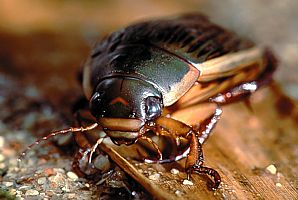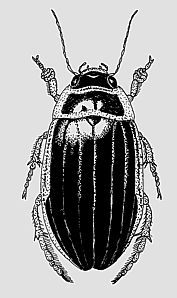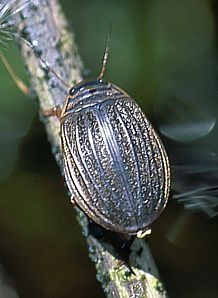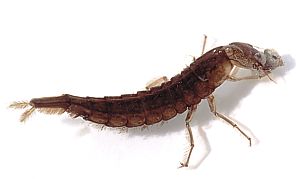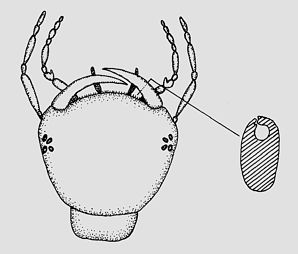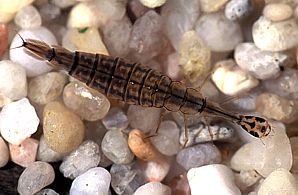|
AQUATIC INSECTS
|
|||||||||||||
Text:
|
Beetles
BEETLES Coleoptera are a big family of insects with a characteristic construction of their wings: the first pair is strongly chitinased, transformed into covers while the second pair is membrane-like, in most cases it is hidden under the covers. Several families of Coleoptera are adapted to living in the water. These include: Dytiscidae, Hydrophilidae, Gyrinidae or Haliplidae. One can observe them on the waters of Wigry National Park; 7 species of Gyrinidae, 11 species of Haliplidae and 47 species of Dytiscidae were noticed in the Park area.
Diving beetles Dytiscidae show a variety of adaptations to live in the water. Adult coleopterans have a flattened body devoid of little hair and growths covered with a special oleiferous secretion of the cutaneous glands. The back limbs are strongly flattened and equipped with thick natatorial stubbles acting as paddles. When Dytiscidae simultaneously throw out all their legs backwards, in contrast to Hydrophilidae whose each limb moves independently. They can stay underwater longer thanks to the water reserve accumulated in the special chambers being found under the covers of wings. Swimming backwards to the water surface they put the end of abdomen out which properly bent can catch a reserve of air. The air wanders to the two last abdomen's pretracheas and then to the system of trachea placed among the wings and the abdomen. In winter, when the water surface is covered with ice they cannot take oxygen from atmospherical air and use the so-called physical gills instead. In view of that the beetle lets a blister of air from the chamber under wings go and it waits till the oxygen from water penetrates the blister. Meanwhile, by the rule of difference of concentrations, carbon dioxide penetrates from the blister to the water. Then the beetle catches back the air full of oxygen from the blister.
Some species of Dytiscidae are the subject to the so-called sexual dimorphism that is to say the differentiation in the construction of body of male and female. Three first elements of males' feet are widened and equipped with special hair or suckers serving to hold back the female during the act of copulation.
Dytiscidae females lay eggs in water or outside the water reservoirs using the moist stumps, mossy stones etc. Eggs can be placed on the surface of plants separately or in line. The females of some species can, with the help of a sharp arranger, place the eggs under the skin of water plants right over the water surface.
Dytiscidae larvae are equipped with a dangerous weapon - sharp dagger-like mandibles, empty in centre which are used by insects to catch and suck up the trophy. Having caught the victim, the larva injects a mixture of digestive enzymes which paralyze and melt the victim and then the larva sucks up this initially digested food.
Not only are larvae predacious, the adult individuals are predacious, too. In contrast to larvae they do not suck up their victims but they crumble and swallow the victim in pieces by means of mandibles. They can attack different little water animals while greater coleopterous can even eat larvae of amphibians and little fishes.
The oldest larvae (last instars) pupate on the shore in the pits dug out on their own. Depending on the sort, eggs, larvae and adult individuals spend the winter period inland. Adult coleopterous can live up to five years.
Water scavenger beetles Hydrophilidae live mostly in vegetation abundant ponds, flood waters and streams. Some species live inland or on the borderland of water and land. They are not as good swimmers as Dytiscidae as their legs are not that hairy and the back of the body is convex. The reserve of air is carried under the wings and in a thin layer of delicate short hair placed in the cover of the trunk and abdomen. From time to time they swim to the water surface and take the air with the help of the so-called respiratory tube (formed from the feeler) and properly shaped lines of little hair on the head. Adult Hydrophilidae are mostly herbivorous while larvae lead a predacious mode of life.
Females can lay eggs in woven cocoons which are carried on the back limbs or attached to the water plants. They can also lay eggs directly to water. Larvae live in very shallow waters. They breathe by means of short pretracheas placed at the end of abdomen. The victims - small water animals - are initially consumed outside the organism of beetle right over the water surface and then are sucked up.
Whirligig beetles Gyrinidae are small coleopterans moving quickly on the water surface in a characteristic circular manner. Their central and back limbs are covered with long natatorial little hair acting perfectly as paddles. Their eyes are divided into the upper and lower part by a transverse furrow - thanks to this device they can simultaneously see what happens both under and over water. They mostly spend their time on the surface of water, sometimes on the floating leaves or on the stones protruding from water. They can dive well however they have to grab different objects so the water did not push them to the surface. They eat living and dead animals swimming on the surface of water.
Crawling water beetles Haliplidae are little coleopterous of convex, oval, sharpened from the back body. They settle the vegetation abundant waters. When swimming they move each leg separately. The reserve of air is carried in a hollow placed between the abdomen and hips. They mainly eat algae. The females lay eggs on the water plants. By means of their sharp little jaws, just like Dytiscidae larvae, they suck up algae. After the period of growth they go ashore and pupate in pits dug out on their own.
|
||||||||||||
|
|
|
